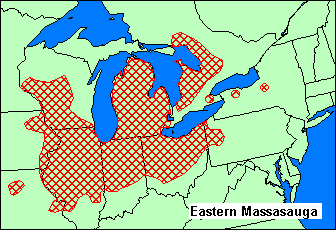The U.S. Fish and Wildlife Service (USFWS) recently announced its final rule to elevate the status of the eastern massasauga rattlesnake (Sistrurus catenatus) to a threatened species under the protection of the Endangered Species Act (ESA). Due to a declining population, this species has been a candidate for listing since 1999. The final rule, which offers protection in the states where the eastern massasauga occurs, takes effect Oct. 31, 2016.
Identifying the Eastern Massasauga Rattlesnake
The eastern massasauga rattlesnake is among the smallest of the North American pit vipers. The average length of an adult is approximately 2 feet. It’s characterized by its gray or light brown skin with large brown spots on the back and smaller spots along the sides.
It typically lives in low-lying, wetland areas, but it may also appear in river floodplains, riparian corridors and adjacent upland areas in the Midwest and Great Lakes regions of North America, specifically Illinois, Indiana, Iowa, Michigan, Minnesota, Missouri, New York, Ohio, Pennsylvania, Wisconsin and Ontario, Canada.
The eastern massasauga rattlesnake preys upon frogs, lizards, other snakes and small rodents. In spring and fall, it’s active during the day when its prey is most active. In the heat of the summer, the eastern massasauga becomes nocturnal. During the cold winter months, eastern massasauga rattlesnakes hibernate in abandoned rodent burrows, and in crevices and caves of rock outcroppings on hillsides.
The Need for Protection
Draining wetlands and converting native grasslands to farmland has reduced and fragmented the available habitat for this species and, as a result, populations of the eastern massasauga rattlesnake have declined significantly. According to the USFWS, nearly 40 percent of known populations are now extirpated and the status of an additional 15 percent are uncertain. The known populations of the eastern massasauga rattlesnake are typically small, isolated and occur on public land, privately owned natural areas, and remnant prairies, bogs and wetlands that haven’t been developed. The USFWS hasn’t designated critical habitat for this species.
 How the Rule Affects Linear Facilities Projects
How the Rule Affects Linear Facilities Projects
The eastern massasauga rattlesnake could pose an issue for development and permits of linear facilities projects — like pipelines, electrical transmission lines, railroads and roadways — that cross wetlands, river floodplains and riparian corridors in the Midwest and Great Lakes regions. The conversion of woodlands, wetlands and native grasslands along linear facility corridors may fragment and/or eliminate potential habitat of the eastern massasauga rattlesnake and its prey.
So what does this mean for your project? Habitat assessments and surveys may be required to determine if a project could adversely affect potential eastern massasauga rattlesnake habitat. The USFWS survey protocol for the eastern massasauga rattlesnake recommends a minimum accumulation of 40 person-hours distributed over a standard field season (April-October) before any evaluations are made regarding the presence/absence of eastern massasauga rattlesnake. Per the USFWS, the majority of the survey hours should be expended in two-time windows reflecting the presumed maximum activity levels of the eastern massasauga rattlesnake: 1) spring emergence, 2) mid- to late-summer basking and birthing period. The timing of surveys can be crucial in project planning to avoid potential project schedule delays.
We have a team of biologists that can assess a project’s potential for protected species issues and offer a variety of avoidance, minimization, survey and mitigation options. Want to learn more? Comment below or connect on LinkedIn. I’d be happy to help.
Photo credit: "Rattlesnake" by USFWSmidwest is licensed under CC BY 2.0.
